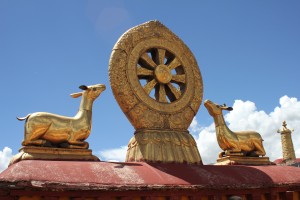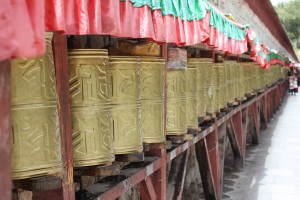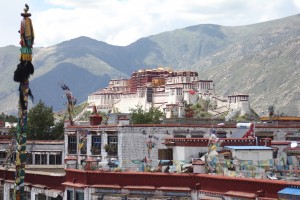When I arrived in Tibet this summer, I had whittled down my ideas of what I might see as much as possible to the one source I found to be credible; though definitely written by a Tibetan Buddhist and so biased in that way, The Tibetan Book of Living and Dying by Sogyal Rinpoche gave me what I felt was an accurate depiction of the religion and belief system of the people before the Communist Revolution. Since my one source was from a Tibetan–and I knew that the film Seven Years in Tibet did not count as a source–I felt compelled to seek the viewpoint of the Han Chinese people as I traveled through mainland China.
Some of my fellow Americans on the trip, seemingly getting most of their notions of Tibet and the Dalai Lama from Hollywood, were demanding explanations for the reasons for abusing the poor last Emperor of China (reference the movie The Last Emperor), or seeking clarification about why Chinese people hate the lovely Dalai Lama because Brad Pitt helped him in the Hollywood film. I wanted to simply ask the young Chinese my age what they thought about the situation in Tibet.
What they told me was generally consistent from person to person: regardless of what Americans believe, Tibet is in fact part of China and has been for hundreds of years. There has always been a special relationship of mutual support between the two countries; China has graciously granted Tibet the status of Semi-Autonomous Region, as it has with the Islamic region of the Uyghurs in the far West of China, or the Special Economic Zone status of Hong Kong. Chinese who are struggling to get by in Beijing are quick to point out that not only are Tibetans allowed to live in newly constructed housing, built by the central government, but get to do so for extraordinarily small amounts of money. Tibetans, as well as other minority groups, are allowed to have two children while the one-child policy binds the lives of the Han Chinese people. New bridges, rail lines, airports, hospitals and schools have also been built by the Chinese government–for their own purposes of course–but the Tibetans benefit from them.
The subject of the Dalai Lama and the fact that Americans perceive Chinese as atheists because of the Communist system was surprising to most Chinese I spoke to. One Chinese person pointed out that it is believed that there had been a type of monarchy in Tibet before Communism that supported a caste system in which average people were desperately poor and relegated to near-slavery by the religious leadership. In China it is believed that the Chinese form of Buddhism is more egalitarian though I could not tell in what way the role of the monks was different in either society. Both Tibetans and Chinese said that the monk’s role was simply to pray for the people and not necessarily conduct charity work. Either way, Buddhist temples are very commonly visited for many reasons throughout the year and Tibet is looked to as a one of the centers of the religion. People practice ideals of Confucian and Taoist beliefs in their daily activities, and there are growing communities of Christians and Muslims throughout the country which the government allows with some restrictions (for instance, Catholic churches are unaffiliated with the Holy Roman See at the Vatican).
When the chance to visit Tibet came up and permission was granted by the Chinese government, I jumped at the opportunity and the chance to see blue skies and breathe clear mountain air. In Tibet, one of the first things the guide–a local Tibetan–told us was that he could not answer any questions at all about the exiled Tibetan government, the Chinese government, the politics of the regions and specifically the status of the Dalai Lama. We were not allowed to leave the hotel on our own other than to buy water next door which was disappointing (but frankly, the pounding headache and shortness of breath from the altitude made us pretty happy to lie down when we got there). Security was heavy on the drive from the airport to Lhasa, and while visiting the temples and palaces we were under surveillance by men on the rooftops and by cameras inside the buildings– a very similar situation to that of the Old City in Jerusalem, where armed police and soldiers stand on many of the corners and cameras watch everything. Our guide was anxious about having to keep an eye on the Americans, as we were one of only two non-Chinese groups in the whole region who were allowed in…and I–this blonde boy–definitely did not blend in with the locals.
What I was able to speak at length about was religion and its role in Tibetan life. Monks and the Dalai Lama are extremely revered to the point of being infallible in the same way of that of the Pope in the Catholic faith. They are on a level above the average Tibetan, and to visit the Jokhram Palace and the Potola Palace in Lhasa is considered one’s obligation in the same way Muslims are supposed to make the Haj pilgrimage to Mecca in their lifetimes. Within the temples and palaces in Lhasa I saw nearly everyone throwing money over the railings to the Buddhas–of which there are dozens–as offerings towards them in return for protection. If true Buddhism is about self-sacrifice for others this act of offering money for one’s own protection seemed to me to be contradictory. As I watched a Chinese couple negotiate the purchase from a monk of yards of gold cloth to be wrapped around a statue of the Buddha for protection, I had the strong feeling that I was watching them buy forgiveness for a sin that was weighing on their conscience.
The Chinese-Tibetan dynamic is full of contradictions; every story, of course, has two sides. I was told by our guide that Tibetans are provided with housing, but it is worth noting that the original town center was demolished by the Chinese government when it built the People’s Liberation Plaza and the giant monument to the military victory over Tibetan rebels. I was told that education is free for Tibetans but that they are required to speak Chinese in school and not Tibetan…and that religion is legal, but pictures of the Dalai Lama are forbidden in public or private. Many jobs have been created by mining activity in the mountains, but perhaps this is to enrich the Central government’s supplies of copper, uranium and plutonium so essential for the growth and development of China.
I learned a great deal about Tibet while I was there, but the inability to talk openly with Tibetans left me feeling that I know little to nothing about what they really think or feel about the situation they live in. I would love to have the opportunity to return, wander the streets, read more books about the Chinese version of the story, and talk openly with both sides to see what the future holds for this beautiful country at the top of the world.



